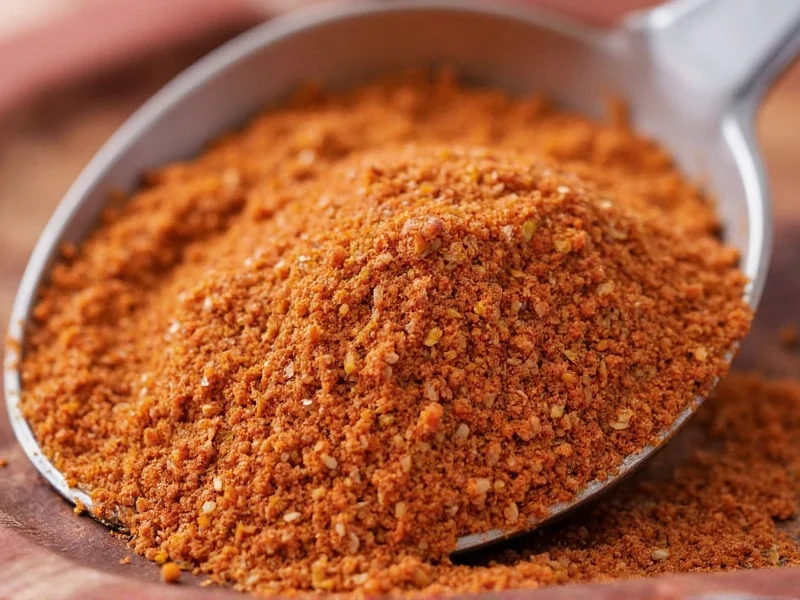The Science Behind Effective Barbecue Rubs
Understanding the chemistry transforms good rubs into exceptional ones. When applied to meat, salt draws out surface moisture through osmosis, creating a brine that later reabsorbs into the meat. This process enhances tenderness while the sugar components caramelize at 320°F (160°C), forming the coveted bark that seals in juices. Professional pitmasters emphasize that rubs don't deeply penetrate raw meat—they create complex flavor layers on the surface where smoke interaction occurs.
Core Components and Their Functions
Every successful barbecue seasoning rub contains four essential elements working in harmony:
| Component | Primary Function | Common Examples | Optimal Percentage |
|---|---|---|---|
| Salt | Moisture control, flavor enhancement | Kosher salt, sea salt, smoked salt | 40-50% |
| Sugar | Caramelization, bark formation | Brown sugar, white sugar, turbinado | 25-35% |
| Spices | Flavor complexity, color development | Paprika, cumin, garlic powder, onion powder | 15-25% |
| Herbs/Aromatics | Fragrance, subtle flavor notes | Thyme, oregano, mustard powder, coffee | 5-10% |
Creating Meat-Specific Rub Formulations
Different proteins require tailored barbecue seasoning rubs. For beef brisket, increase black pepper (20-25% of spice component) and add coffee powder for depth. Pork ribs benefit from higher brown sugar content (up to 40% of total blend) and a touch of cayenne. When making poultry rubs, reduce sugar to prevent burning and emphasize herbs like thyme and rosemary. The best barbecue rub for smoked brisket maintains a 3:2:1 ratio of salt:sugar:spices with additional cracked pepper.
Professional Application Techniques
Timing and method significantly impact results. Apply rubs at least 1 hour before cooking, but for maximum flavor development, refrigerate meat with rub for 12-24 hours. Use a circular motion to help ingredients adhere—this creates microscopic abrasions that improve bark formation. When applying rub before smoking, use approximately 1 tablespoon per pound of meat. Avoid pressing too hard, which can damage meat fibers. For optimal smoke ring formation with dry rubs, skip oiling the meat surface as fats can block smoke absorption.
Common Rub Mistakes and Solutions
Many backyard grillers make these critical errors:
- Sugar burning: Reduce sugar content for long smokes above 250°F (121°C) or use alternative sweeteners like date sugar
- Inconsistent texture: Grind whole spices yourself for uniform particle size—pre-ground spices often contain anti-caking agents
- Over-salting: Measure by weight, not volume, as different salt crystals vary significantly in density
- Poor adhesion: Pat meat completely dry before application—surface moisture prevents proper rub adherence
Developing Your Signature Blend
Create custom barbecue rub recipes for different meats by following this systematic approach:
- Start with 100g base (50g salt, 30g sugar, 20g spices)
- Choose primary flavor profile (smoky, sweet, spicy, herbal)
- Add dominant spice (e.g., 8g smoked paprika for smoky profile)
- Incorporate supporting spices (4g garlic powder, 3g onion powder)
- Add accent ingredients (2g cumin, 1g cayenne)
- Test on small meat portion before full application
- Adjust ratios based on cooking method and meat type
Document your experiments to refine your homemade barbecue seasoning over time. Remember that humidity affects rub performance—store blends in airtight containers with oxygen absorbers for maximum barbecue rub storage life.
Frequently Asked Questions
When should I apply rub before smoking meat?
Apply rubs at least 1 hour before cooking, but for optimal flavor development, refrigerate meat with rub for 12-24 hours. This allows salt to penetrate while sugar and spices form a pellicle that enhances smoke absorption and bark formation during the smoking process.
What's the difference between a dry rub and marinade for barbecue?
Dry rubs create flavorful crusts through surface reactions without moisture, while marinades use acidic liquids to tenderize. Rubs work better for low-and-slow smoking as they promote bark formation, whereas marinades can prevent proper smoke absorption and cause steaming rather than searing at high temperatures.
How do I prevent my barbecue rub from burning?
Reduce sugar content to 20-25% for cooking above 250°F, use alternative sweeteners like date sugar that caramelize at higher temperatures, or apply sugar-containing rubs during the final 30-60 minutes of cooking. For long smokes, create a two-stage rub system with sugar-free initial application.
Can I use the same rub for different meats?
While versatile base rubs work for multiple proteins, optimal results come from meat-specific adjustments. Increase pepper for beef, boost sugar for pork, reduce sugar for poultry, and add citrus zest for seafood. The best barbecue rub for smoked brisket differs from ideal poultry blends due to varying fat content and cooking temperatures.
How long does homemade barbecue seasoning last?
Properly stored in airtight containers away from light and moisture, homemade rubs maintain peak flavor for 6-12 months. Whole spices last longer than pre-ground—consider storing base components separately and grinding before use. For extended barbecue rub storage, include oxygen absorbers and check for aroma loss or color changes indicating degradation.











 浙公网安备
33010002000092号
浙公网安备
33010002000092号 浙B2-20120091-4
浙B2-20120091-4